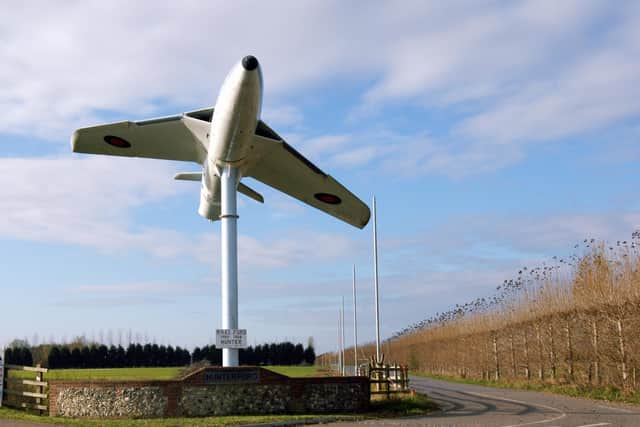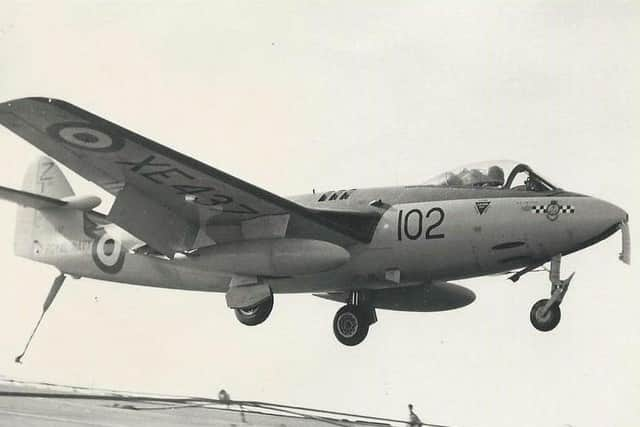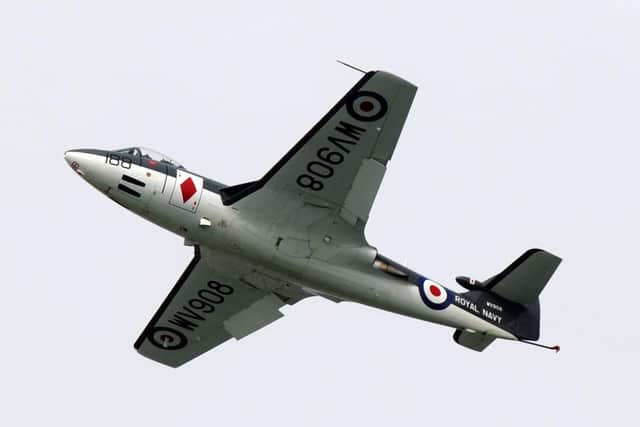Royal Navy veteran tells of tragic day at Ford
and live on Freeview channel 276
Mr Ford a member of Itchenor Sailing Club, was in the Fleet Air Arm and was at Ford when preparations were being made for a flypast for the Queen.
He was enjoying himself, as a young man who had achieved his ambition of flying a jet fighter, but during the course of the afternoon, a tragic incident showed him the realities of the role he had chosen.
Advertisement
Hide AdAdvertisement
Hide AdMr Ford, now 91 and living in Cranleigh, explained: “The village of Ford has had a long connection with aviation, dating back to 1919. Early under naval control, the airfield reverted to the Royal Air Force, which based fighter squadrons there during the Battle of Britain and later sent out intruder missions over France.


“It once again became a stone aircraft carrier, HMS Peregrine, and host to Fleet Air Arm squadrons in 1945.
“In 1955, a group of us young pilots returning from flying training in the US were posted to Ford to convert to the Navy’s frontline day fighter, the Hawker Sea Hawk, before moving on to a frontline squadron based in Scotland.
“We were young men thrilled to have achieved our ambition of flying a jet fighter in an operational squadron, confident in our new skills.
Advertisement
Hide AdAdvertisement
Hide Ad“The squadron was occasionally required to fly down to Ford for trials or an exercise, and eventually to stage through on the way to embark in our first aircraft carrier steaming in the Channel.


“Orders were received for the two Sea Hawk squadrons at Lossiemouth to deploy to Ford on July 27, 1956, in preparation for a massed FAA flypast in celebration of the Queen’s birthday, due to take place two days later.
“The weather on the day was poor with a low cloud base hugging the tops of the South Downs. Our procedure was to join up in pairs above cloud before letting down under radar control from Ford, the leader concentrating on his flight instruments and the wingman hanging on visually in close formation.
“All my squadron landed safely and we were watching the arrival of the others as pairs dropped out from the gloomy cloud base. The next to come into sight was a singleton.
Advertisement
Hide AdAdvertisement
Hide Ad“As it taxied in, we were shocked to see vegetation jammed between the undercarriage legs. When the white-faced pilot eventually climbed from the cockpit, he told us his story.


“Descending in thick cloud, he suddenly found the undercarriage brushing though the tops of a field of crops and, pulling up instinctively, his survival granted by the height of a corn stalk. He was then faced with composing himself sufficiently to concentrate on flying an orbit and making a second instrument approach.
“The wreckage of the other aircraft was found scattered across the Downs and another young man had lost his life. His death added to more than 900 FAA aircrew who died in combat or accident, in the service of their country, between 1945 and the end of the century.
“The younger pilots in the squadron were now experiencing at first hand the reality of life in the FAA, that the thrills and enjoyment of chasing each other across the sky had another and darker side, life could be snuffed out in a flicker of time.”
Advertisement
Hide AdAdvertisement
Hide AdSadly, Lieutenant Peter Flower, 24, from HMS Fulmar lost his life when his Sea Hawk struck high ground near Chanctonbury Ring in fog en route from RNAS Lossiemouth to Ford.
The inquest was held at Shoreham Town Hall in October 1956 and reported in the West Sussex Gazette.
Police Constable Clout from Washington said he found the wreckage of the aircraft spread over a large area. There was a heavy mist and visibility was down to five or ten yards.
Near the wreckage was a clear mark in a cornfield, indicating where the other aircraft had sheared the top off the corn.
No cause for the crash was found.